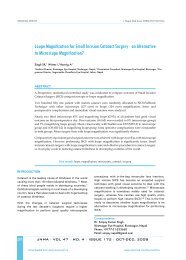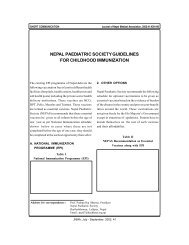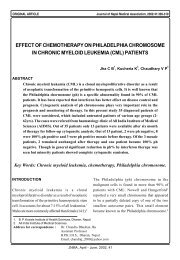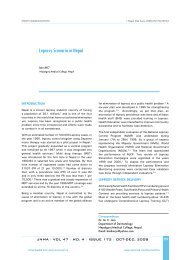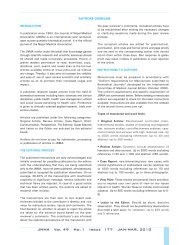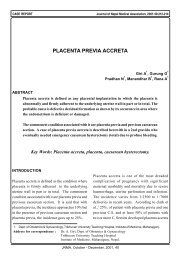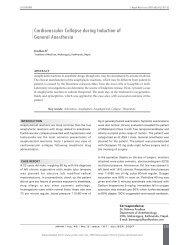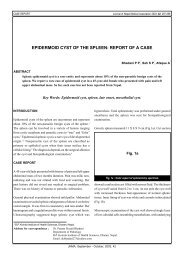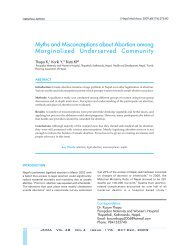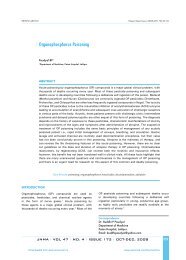JNMA (142) Final - Journal of Nepal Medical Association
JNMA (142) Final - Journal of Nepal Medical Association
JNMA (142) Final - Journal of Nepal Medical Association
Create successful ePaper yourself
Turn your PDF publications into a flip-book with our unique Google optimized e-Paper software.
CASE REPORT <strong>Journal</strong> <strong>of</strong> <strong>Nepal</strong> <strong>Medical</strong> <strong>Association</strong>, 2002:41:323-325<br />
CRYPTOCOCCAL MENINGITIS IN A NON-AIDS PATIENT<br />
Khanal B 1 , Sharma S K 1 , Deb M 1<br />
ABSTRACT<br />
Cryptococcal meningitis that occurred in a patient with no obvious<br />
predisposing factor is reported. The necessity to identify this entity in the<br />
cases <strong>of</strong> chronic meningitis is discussed.<br />
Key Words: Meningitis, Cryptococcus ne<strong>of</strong>ormans.<br />
INTRODUCTION<br />
Cryptococcosis is an infection caused by an<br />
encapsulated yeast Cryptococcus ne<strong>of</strong>ormans,<br />
considered to be rare prior to Acquired Immune<br />
Deficiency Syndrome (AIDS) epidemic. Although<br />
AIDS is now the major predisposing factor for<br />
cryptococcosis, this condition is also reported in<br />
non – AIDS group which includes a large<br />
percentage <strong>of</strong> patients with deficiencies in cell<br />
mediated immunity and some others without any<br />
obvious predisposing factor. 1-3<br />
Any organ or tissue is subject to invasion by<br />
this saprophytic fungus after it enters the host<br />
by inhalation. However, due to its<br />
neurotropism, meningitis is the commonly<br />
encountered manifestation <strong>of</strong> cyptococcosis. 2,3<br />
Subacute onset, indolent course and the<br />
nonspecific presentations <strong>of</strong> the disease<br />
resemble tuberculous meningitis. 2,3 We report<br />
a case <strong>of</strong> cryptococcal meningitis that occurred<br />
in a Human Immunodeficiency Virus (HIV)<br />
negative patient who was initially treated for<br />
tuberculous meningitis due to similar clinical<br />
features.<br />
CASE REPORT<br />
A 35 years male, businessman, resident <strong>of</strong><br />
Jhapa in Eastern <strong>Nepal</strong> presented to the<br />
Emergency <strong>of</strong> B P Koirala Institute <strong>of</strong> Health<br />
Sciences Hospital, with 22 days history <strong>of</strong> high<br />
grade fever, headache followed by altered<br />
1. B. P. Koirala Institute <strong>of</strong> Health Sciences, Dharan, <strong>Nepal</strong>.<br />
Address for correspondence : Dr. Basudha Khanal<br />
Department <strong>of</strong> Microbiology<br />
B. P. Koirala Institute <strong>of</strong> Health Sciences, Dharan, <strong>Nepal</strong><br />
Phone: 00977-25-25555, Ext.: 2614, Fax: 977-25-20251<br />
Email: basudhak@hotmail.com, basudhak@yahoo.com<br />
<strong>JNMA</strong>, April - June, 2002, 41
Khanal et. al. : Cryptococcal Meningitis in a Non-Aids Patient 324<br />
sensorium <strong>of</strong>f and on. He reported to a local<br />
hospital where he was started on<br />
antituberculous therapy (ATT) and steroid for<br />
the same complaints. Improvement was not<br />
observed and the patient reported to this<br />
hospital after one week. His past history and<br />
family history were not contributory.<br />
On examination he was drowsy, neck rigidity<br />
and Kerning sign were present. Other<br />
examination did not reveal any abnormality.<br />
X-ray chest taken a week earlier showed<br />
bilateral apical opacity. In view <strong>of</strong> these<br />
findings, provisional diagnosis <strong>of</strong> TB meningitis<br />
was made and the ATT was continued.<br />
Post admission a few laboratory investigations<br />
were done to obtain baseline data. Hemogram,<br />
blood sugar and renal pr<strong>of</strong>ile were within<br />
normal limits. Lumbar puncture was done,<br />
Fig. 1<br />
Cerebrospinal fluid (CSF) was clear. There<br />
were no cells but high protein (108 mg/dl) and<br />
less glucose (24 mg/dl) were a significant<br />
findings. Ziehl Neelsen stained smear did not<br />
show any acid fast bacilli. Gram variable<br />
structures surrounded by a wide halo but no<br />
inflammatory cells observed in grams staining<br />
led to the suspicion <strong>of</strong> cryptococcal infection.<br />
India Ink preparation <strong>of</strong> centrifuged deposits<br />
<strong>of</strong> CSF revealed multiple, capsulated, budding<br />
yeast cells characteristic <strong>of</strong> C. ne<strong>of</strong>ormans<br />
(Figure). On this finding diagnosis <strong>of</strong><br />
cryptococcal meningitis was made and<br />
treatment was started with Amphotericin B.<br />
Screening Enzyme linked immunosorbent<br />
assay (ELISA) <strong>of</strong> his serum was negative for<br />
HIV antibody. Due to lack <strong>of</strong> facilities other<br />
parameters for a deficient cell mediated<br />
immunity, could not be assessed. CSF culture<br />
for pyogenic meningitis and tuberculosis were<br />
sterile. Culture <strong>of</strong> CSF on Sabouraud’s<br />
Dextrose Agar (SDA) yielded creamy white<br />
colony <strong>of</strong> budding yeast cells after 48 hours <strong>of</strong><br />
incubation. C. ne<strong>of</strong>ormans was diagnosed on<br />
the basis <strong>of</strong> characteristic morphology, growth<br />
at 37 0 C and biochemical reactions 3 .<br />
The patient improved clinically. CSF<br />
microscopy and culture repeated after 7 days<br />
were sterile. However, patient left against<br />
medical advice before the therapy could be<br />
completed.<br />
DISCUSSION<br />
Fig. 1, India Ink preparation <strong>of</strong> cerebrospinal fluid<br />
showing capsulated and budding morphology <strong>of</strong><br />
Crytococcus ne<strong>of</strong>ormans ( X 1000).<br />
The dramatic increase in the number <strong>of</strong> cases<br />
<strong>of</strong> cryptococcosis in various parts <strong>of</strong> the world<br />
is attributed to the ever increasing population<br />
<strong>of</strong> immunocompromised host as a result <strong>of</strong><br />
chemotherapy and organ transplantation and<br />
disease like AIDS. Awareness among clinicians<br />
and microbiologist <strong>of</strong> this infection have also<br />
<strong>JNMA</strong>, April - June, 2002, 41
325 Khanal et. al. : Cryptococcal Meningitis in a Non-Aids Patient ...<br />
contributed significantly to the diagnosis in<br />
recent time. 3 C. ne<strong>of</strong>ormans can infect skin,<br />
bone, and other visceral organs but has<br />
predilection for the central nervous system.<br />
Bilateral opacity in the apices <strong>of</strong> the lungs <strong>of</strong><br />
this patient is suggestive <strong>of</strong> a primary<br />
pulmonary infection which was possibly<br />
asymptomatic.<br />
The diagnosis <strong>of</strong> cryptococcal meningitis can be<br />
very challenging since onset <strong>of</strong> symptom is usually<br />
subacute or chronic and runs an indolent course<br />
resembling several other conditions including TB<br />
meningitis which is common in this part <strong>of</strong> the<br />
world. Although, cryptococcal meningitis is<br />
reported from various parts <strong>of</strong> the world both in<br />
immunocompromised and immunocompetent<br />
individuals, to the best <strong>of</strong> our knowledge this is<br />
the first reported case <strong>of</strong> cryptococcal meningitis<br />
in <strong>Nepal</strong>. 1,4-6 For the effective management <strong>of</strong> such<br />
cases the diagnosis is most crucial which is based<br />
on a high index <strong>of</strong> suspicion both in<br />
immunocompromised and immunocompetent<br />
individuals, presenting with subacute or chronic<br />
meningitis. Prompt diagnosis and immediate<br />
institution <strong>of</strong> the antifungal therapy are essential<br />
to prevent the morbidity and mortality caused by<br />
this illness.<br />
It is therefore concluded that a differential<br />
diagnosis <strong>of</strong> cryptococcal meningitis should be<br />
always kept in mind in all cases <strong>of</strong> subacute<br />
and chronic meningitis. Simple microbiology<br />
technique <strong>of</strong> India Ink preparation and direct<br />
microscopy could help to arrive at a rapid<br />
diagnosis and immensely help the clinician in<br />
the management.<br />
REFERENCES<br />
1. Mitchell TG, Perfect JR Cryptococcosis in the era<br />
<strong>of</strong> AIDS – 100 years after the discovery <strong>of</strong><br />
Cryptococcus ne<strong>of</strong>ormans. Clin Microbiol Rev.<br />
1995; 8:515-548.<br />
2. Diamond RD. Cryptococcus ne<strong>of</strong>ormans, In:<br />
Mandell GT, Bennett JE, Dolin R, eds. Mandell,<br />
Doughlas and Bennett’s Principles and Practice<br />
<strong>of</strong> Infectious diseases, vol. 2, Philadelphia, Churchill<br />
Livingstone, 2000: 2707 – 2718.<br />
3. Cox GM, Perfect JR. Cryptococcus ne<strong>of</strong>ormans<br />
var ne<strong>of</strong>ormans and gattii and Trichosporon<br />
species, In: Ajello L, Hay RJ, eds. Topley and<br />
Wilson’s Microbiology and Microbial infection, vol<br />
4, London, Arnold, 1998: 461 – 484.<br />
4. Sanchetee PC. Cryptococcal meningitis in<br />
immunocompetent host, J Assos Phys India 1998;<br />
46:617-619.<br />
5. Madan M, Ranjitham M, Chandrasekaran S,<br />
Sudhakar, Cryptococceal meningitis in<br />
Immunocompetent Individuals. J Assos Phys India<br />
1999; 47:933-934.<br />
6. Chuck SL, Saunde MA. Infection with Cryptococcus<br />
ne<strong>of</strong>ormans in the acquired immunodeficiency<br />
syndrome, N Engl J Med 1989; 321:794-799.<br />
!""!""!<br />
<strong>JNMA</strong>, April - June, 2002, 41



